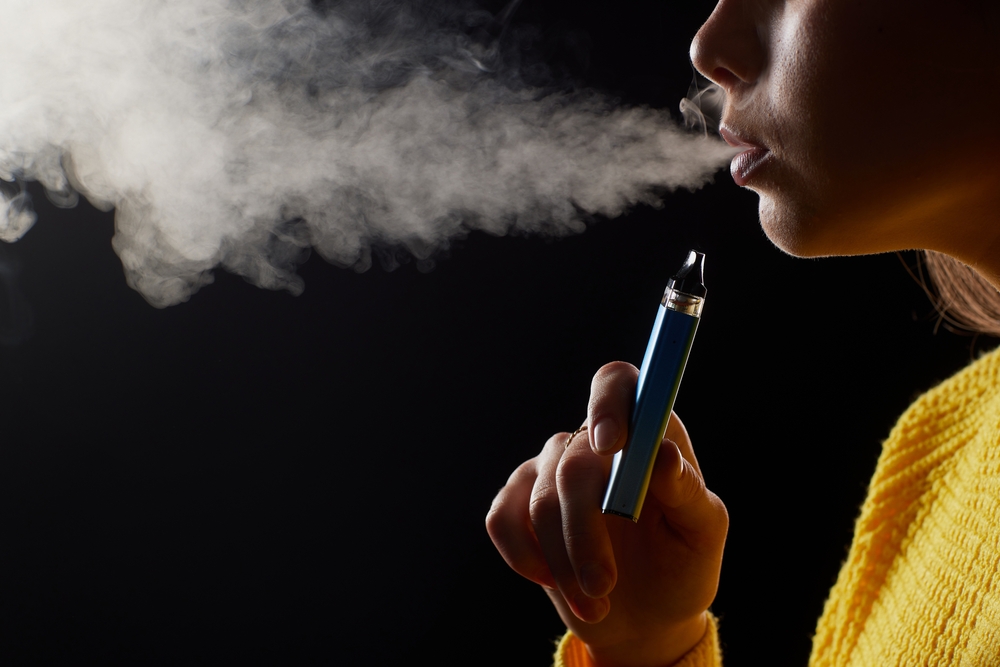Vaping Has Officially Been Linked To Rare And Irreversible Lung Disease

Imagine breathing through a straw for the rest of your life. Every inhale a struggle. Every breath a reminder.
That’s the reality some young people are now facing—not because of cigarettes, not because of lifelong pollution exposure, but because of a sleek, flavored device once marketed as the “safe” alternative: the vape pen.
Once hailed as a modern solution to smoking, vaping has quickly revealed its darker side. Behind clouds of mango mist and bubblegum haze lies something much more dangerous—chemicals that, when inhaled, can scar your lungs permanently. The kind of damage that doesn’t heal with time. The kind of disease that doctors call irreversible.
It’s called popcorn lung, a rare but serious condition once seen mostly in factory workers inhaling artificial butter fumes. Now, teens and young adults—many of whom never smoked a single cigarette—are ending up in intensive care with similar injuries. And this isn’t just an isolated case or media exaggeration. The medical evidence is mounting, and it’s time we start listening.
The Silent Storm: Why This Matters Now
According to the CDC, more than 14% of U.S. high school students reported current e-cigarette use in 2022. That’s over 2 million teenagers. And among high school seniors, more than 40% have tried vaping. These numbers aren’t just statistics—they represent a generation exposed to a product whose long-term effects are still largely unknown, yet increasingly associated with serious health consequences.
Here’s what makes this particularly alarming: e-cigarettes were initially pitched as a tool to help adults quit smoking. But somewhere along the way, they were hijacked by candy-flavored marketing and sleek designs that appealed to a much younger audience—many of whom had never smoked a cigarette to begin with. The result? A new wave of nicotine dependence and lung damage, now hitting teens with conditions we previously only saw in middle-aged factory workers or heavy smokers.

And despite laws banning e-cigarette sales to anyone under 21 in most U.S. states, enforcement is weak. Illicit vapes, often unregulated and chemically unstable, flood the market through social media, street vendors, and even convenience stores. Many of these products contain substances that bypass safety testing altogether—sometimes with deadly results.
We’ve already seen this play out before. The EVALI outbreak (E-cigarette or Vaping product use-Associated Lung Injury) in 2019 hospitalized over 2,800 people and claimed 68 lives. That outbreak was eventually linked to vitamin E acetate in THC vape products—a contaminant never meant to enter human lungs. But even after that public health emergency, the vaping industry continues to evolve faster than the science trying to catch up.
What makes vaping dangerous isn’t just the nicotine—it’s the chemical complexity, the regulatory gaps, and the illusion of safety. It’s a silent storm because the damage doesn’t always strike immediately. But it builds. In the lungs. In the bloodstream. In the habits and minds of millions of youth.
What Is Popcorn Lung – And Why You Should Care

The name sounds almost ridiculous—popcorn lung—but there’s nothing amusing about what it does to the body. Officially known as bronchiolitis obliterans, this rare but devastating disease causes scarring and narrowing of the lungs’ smallest airways, called bronchioles. Once the damage is done, there’s no going back. It’s permanent. Irreversible. And in severe cases, life-threatening.
The nickname “popcorn lung” comes from a real-world case in the early 2000s when workers at a microwave popcorn plant began falling mysteriously ill. The common thread? Repeated inhalation of diacetyl, a chemical used to give popcorn its buttery flavor. While safe to eat, diacetyl turned out to be toxic when inhaled. The result: wheezing, chronic cough, fatigue, and serious respiratory decline that, in some cases, required lung transplants.
Many vape liquids—especially flavored ones—contain diacetyl or its chemical cousins like acetoin and 2,3-pentanedione. Though banned in e-liquids in the UK and EU, diacetyl is still permitted in the U.S. in some products. And illegal or counterfeit vape cartridges, which are alarmingly easy for teens to access, may include it without disclosure. These chemicals, when aerosolized and inhaled into the lungs, behave much like they did in those factory settings—burning, scarring, and narrowing the airways.
And it doesn’t take years of use to trigger this kind of damage.
Take the case of a Canadian teenager who vaped flavored cartridges daily for just five months. After developing a fever and severe cough, his lungs began to shut down. He spent 47 days in the hospital and nearly needed a double lung transplant. Doctors diagnosed him with acute bronchiolitis—consistent with early popcorn lung—and found no other explanation but vaping.
Now, here’s what’s important to understand: while not all vapers will develop popcorn lung, the risk is real, especially when using unregulated or flavored products. And because the condition mimics common respiratory issues in its early stages, it can be dangerously easy to miss until it’s progressed too far.
Popcorn lung isn’t cancer. It won’t show up on a blood test. But it will slowly steal your breath, your energy, and your quality of life. And right now, millions of young people are unknowingly playing chemical roulette with every puff.
The Flavor Trap: How Vaping Delivers Hidden Harm

Bubblegum. Cotton candy. Mango ice. These aren’t just nostalgic treats—they’re some of the most popular vape flavors on the market, and they’re pulling in a generation that might never have smoked a single cigarette. But behind the sugary names and sleek packaging lies a chemical cocktail with consequences most users never see coming.
The appeal is obvious. Flavored e-liquids mask the harshness of nicotine and make vaping feel harmless—fun, even. But those flavors are not just benign additives. They’re engineered compounds designed for taste, not safety. While many of these chemicals are approved for ingestion in food, inhaling them is a different story entirely.
Here’s the key distinction: when you eat something, it passes through the digestive system and is filtered by the liver before reaching the bloodstream. This natural filtration process reduces the toxic load your body absorbs. But when you inhale a chemical—whether it’s diacetyl, formaldehyde, or acetaldehyde—it bypasses those filters, heading straight to the lungs and, from there, into your bloodstream within seconds. That means your heart, brain, and other organs are immediately exposed.
Even more alarming is what happens when these flavoring agents are heated. At vaping temperatures, many break down into new compounds—some of which have never been tested for inhalation safety. Scientists have identified more than 180 different chemicals used in vape flavorings, and many of them, when aerosolized, become volatile organic compounds (VOCs), or release ultrafine particles that lodge deep in the lungs. Some have even been found to produce carcinogenic byproducts.
Let’s not forget heavy metals like nickel, tin, and lead, which can leach from the heating coils and become part of the aerosol you inhale. These aren’t theoretical risks—they’ve been measured in lab studies and detected in the lungs of hospitalized vape users.
And for those thinking, “Well, it’s not like I’m vaping every hour”, know this: even occasional exposure to harmful chemicals can cause inflammation and early signs of lung damage. The cumulative effect of repeated, low-level inhalation—especially in young, developing lungs—could take years to fully understand. But early warning signs are already flashing red.
This is the trap: what feels like a light, flavorful escape is often a chemical Trojan horse, delivering damage one puff at a time. The vapor smells like candy, but it behaves like a corrosive. And most users don’t realize it—until they’re coughing, wheezing, or waking up in a hospital bed.
The Human Cost: Teenagers, Addiction, and Lifelong Damage

For many teenagers, vaping starts innocently. A hit at a party. A puff between classes. A harmless habit—so they think. But the statistics tell a different story. According to the CDC, over 2 million U.S. high school students currently vape. That’s not an accident. It’s the result of calculated marketing, youth-friendly flavors, and devices designed to be as discreet as a USB stick and just as addictive as a cigarette.
Nicotine is no small thing, especially for the developing brain. It alters pathways responsible for attention, learning, and impulse control. It changes how the brain responds to stress and reward. And once that dependency forms, quitting becomes a mental and physical battle—one that many teens are ill-equipped to fight.
But nicotine isn’t the only danger. As we’ve already explored, the flavored vapors themselves can carry a toxic payload. Some teens, like the 17-year-old in Canada who nearly needed a double lung transplant after just five months of daily vaping, find out too late that the damage goes beyond addiction. His was a body in crisis—lungs inflamed, bronchioles scarred, and no clear cure in sight. What started as an experiment with flavored THC cartridges became a brush with death.
Then there’s the 2019 EVALI outbreak in the U.S.—a stark reminder of just how quickly vaping can turn deadly. Over 2,800 people were hospitalized, and 68 died, many of them previously healthy young adults. The culprit was traced to vitamin E acetate, a thickening agent in certain cannabis vape products. It wasn’t listed on labels. It wasn’t supposed to be there. But it was inhaled—and it killed.
Even beyond acute injuries, the broader health risks are mounting:
- Chronic respiratory issues.
- Exposure to cancer-causing chemicals.
- Heavy metal toxicity.
- Increased likelihood of transitioning to traditional cigarettes.
And what makes it worse? Many teens believe they’re vaping “nicotine-free” products, only to discover—sometimes through addiction symptoms—that the liquid contains nicotine after all. Mislabeling, illegal imports, and black-market vapes are rampant, and regulation is still struggling to catch up.
We are witnessing a generation of non-smokers becoming addicted to nicotine and developing health issues once thought reserved for longtime smokers. Not out of rebellion—but out of misinformation and manipulation.
Myths vs. Truth: What Science Really Says

In the smoky haze of online debates and influencer endorsements, it’s hard to separate facts from fiction. Vaping has been surrounded by a fog of myths—some born from marketing, others from wishful thinking. But science is starting to clear the air, and what it reveals demands attention.
Myth #1: “Vaping is just flavored water vapor.”
Let’s be clear: vape aerosol is not harmless steam. It contains ultrafine particles, volatile organic compounds, heavy metals like nickel and lead, and carcinogenic chemicals—even in products labeled as “clean” or “organic.” The flavor may smell like strawberries, but the science shows it behaves more like an industrial byproduct.
Myth #2: “It’s way safer than smoking.”
This is partially true—but dangerously misleading. While vaping likely exposes users to fewer toxic substances than traditional cigarettes, “less harmful” doesn’t mean safe. Studies have found that vaping can still lead to chronic lung injury, inflammation, and impaired immune response in the lungs. Some e-cigarette users even develop dual habits—vaping and smoking—which compounds the risk rather than reducing it.
As Dr. Michael Blaha of Johns Hopkins Medicine puts it: “People need to understand that e-cigarettes are potentially dangerous to your health. Emerging data suggest links to chronic lung disease and asthma, and associations between dual use of e-cigarettes and smoking with cardiovascular disease.”
Myth #3: “There’s no proof vaping causes popcorn lung.”
It’s true that no widespread epidemic of popcorn lung from vaping has been confirmed. But this misses the point. Cases of bronchiolitis obliterans have been documented in vape users, and exposure to diacetyl—a known cause—has been found in many flavored vape liquids. Just because a disease isn’t widespread yet doesn’t mean the risk isn’t real. Remember: cigarettes took decades to be proven deadly. Are we really going to wait that long again?
Myth #4: “Vaping helps people quit smoking.”
Some smokers have reported success quitting through vaping. But studies show mixed results. Many users don’t actually quit—they simply switch or become dual users. More importantly, the FDA has not approved e-cigarettes as a smoking cessation tool. And for young people who’ve never smoked, vaping is a gateway in, not a way out.
Myth #5: “Nicotine-free vapes are safe.”
Not necessarily. Even nicotine-free e-liquids often contain chemical additives and flavorings that, when heated, form new compounds with unknown long-term health effects. Plus, studies have shown that some supposedly nicotine-free products actually do contain nicotine, due to cross-contamination or misleading labeling.

The truth is this: vaping is a fast-evolving industry pushing unregulated products into the hands of a generation still learning how to think critically. The science is playing catch-up, but early results are troubling. And while some public health experts see vaping as a lesser evil for adult smokers, that does not make it a safe or smart choice—especially for youth. When we peel back the hype, the science tells us a simple truth: our lungs were meant to breathe air, not chemicals.
What We Must Do Next
We know enough now to stop pretending vaping is harmless. We’ve seen teenagers with lungs so damaged they face a lifetime of breathing support. We’ve watched hospital admissions rise. We’ve heard the warnings from public health officials. Yet the allure remains, often stronger than the science. So what can we do?
For young people: Question the appeal. Ask yourself who profits from your habit and what you’re really trading for that five-second flavor hit. Is it worth your breath? Your freedom? Your future?
For parents, educators, and guardians: Create space for open dialogue, not just punishment. Listen first. Inform second. Help teens understand that this isn’t a moral failing—it’s a manufactured trap.
For regulators and lawmakers: It’s time for stronger oversight. Mandatory ingredient transparency. Flavor bans. Real enforcement. The same urgency we applied to curbing cigarette use must now be aimed at vaping—before the next generation becomes its next casualty.
For all of us: Stay informed. Share what you know. Speak up. Small conversations can spark big shifts, especially when they’re rooted in truth.
The Breath You Save Could Be Your Own
Vaping was never supposed to be a problem. It was marketed as a solution. But like many things sold with slick branding and sweet flavor, the danger was hidden in the details—and now it’s surfacing in emergency rooms, in medical journals, and in the lungs of teenagers who thought they were just trying something cool.
This isn’t about fear. It’s about awareness. It’s about refusing to let another generation walk into harm’s way while we look the other direction.
If even one person pauses before picking up a vape—if even one conversation helps shift the narrative—then this message matters.
So ask yourself: What are we inhaling? What are we accepting? And what legacy are we willing to leave behind?
Because when it comes to vaping, the breath you save could be your own.

